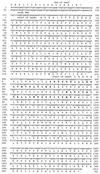vanC cluster of vancomycin-resistant Enterococcus gallinarum BM4174
- PMID: 10817725
- PMCID: PMC89929
- DOI: 10.1128/AAC.44.6.1660-1666.2000
vanC cluster of vancomycin-resistant Enterococcus gallinarum BM4174
Abstract
Glycopeptide-resistant enterococci of the VanC type synthesize UDP-muramyl-pentapeptide[D-Ser] for cell wall assembly and prevent synthesis of peptidoglycan precursors ending in D-Ala. The vanC cluster of Enterococcus gallinarum BM4174 consists of five genes: vanC-1, vanXY(C), vanT, vanR(C), and vanS(C). Three genes are sufficient for resistance: vanC-1 encodes a ligase that synthesizes the dipeptide D-Ala-D-Ser for addition to UDP-MurNAc-tripeptide, vanXY(C) encodes a D,D-dipeptidase-carboxypeptidase that hydrolyzes D-Ala-D-Ala and removes D-Ala from UDP-MurNAc-pentapeptide[D-Ala], and vanT encodes a membrane-bound serine racemase that provides D-Ser for the synthetic pathway. The three genes are clustered: the start codons of vanXY(C) and vanT overlap the termination codons of vanC-1 and vanXY(C), respectively. Two genes which encode proteins with homology to the VanS-VanR two-component regulatory system were present downstream from the resistance genes. The predicted amino acid sequence of VanR(C) exhibited 50% identity to VanR and 33% identity to VanR(B). VanS(C) had 40% identity to VanS over a region of 308 amino acids and 24% identity to VanS(B) over a region of 285 amino acids. All residues with important functions in response regulators and histidine kinases were conserved in VanR(C) and VanS(C), respectively. Induction experiments based on the determination of D,D-carboxypeptidase activity in cytoplasmic extracts confirmed that the genes were expressed constitutively. Using a promoter-probing vector, regions upstream from the resistance and regulatory genes were identified that have promoter activity.
Figures





References
-
- Arias C A, Martín-Martinez M, Blundell T L, Arthur M, Courvalin P, Reynolds P E. Characterization and modelling of VanT, a novel, membrane-bound, serine racemase from vancomycin-resistant Enterococcus gallinarum BM4174. Mol Microbiol. 1999;31:1653–1664. - PubMed
-
- Arthur M, Reynolds P E, Courvalin P. Glycopeptide resistance in enterococci. Trends Microbiol. 1996;4:401–407. - PubMed
Publication types
MeSH terms
Substances
LinkOut - more resources
Full Text Sources
Medical
Molecular Biology Databases

